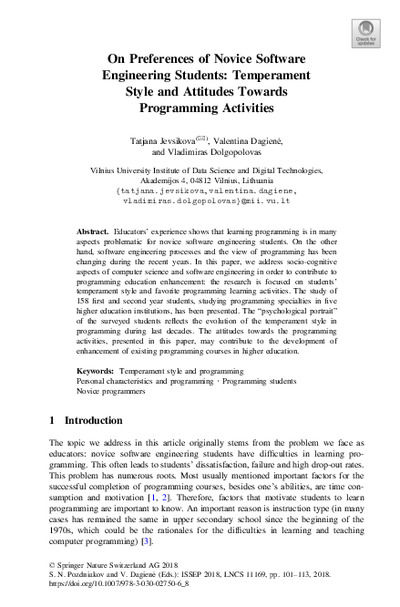On Preferences of Novice Software Engineering StudentsTemperament Style and Attitudes Towards Programming Activities
Tatjana Jevsikova, Valentina Dagienė, Vladimiras Dolgopolovas
Zu finden in: Informatics in Schools: Fundamentals of Computer Science and Software Engineering (Seite 101 bis 113), 2018
  |
 |
 Diese Seite wurde seit 2 Jahren inhaltlich nicht mehr aktualisiert.
Unter Umständen ist sie nicht mehr aktuell.
Diese Seite wurde seit 2 Jahren inhaltlich nicht mehr aktualisiert.
Unter Umständen ist sie nicht mehr aktuell.
 Zusammenfassungen
Zusammenfassungen
 Educators’ experience shows that learning programming is in many aspects problematic for novice software engineering students. On the other hand, software engineering processes and the view of programming has been changing during the recent years. In this paper, we address socio-cognitive aspects of computer science and software engineering in order to contribute to programming education enhancement: the research is focused on students’ temperament style and favorite programming learning activities. The study of 158 first and second year students, studying programming specialties in five higher education institutions, has been presented. The “psychological portrait” of the surveyed students reflects the evolution of the temperament style in programming during last decades. The attitudes towards the programming activities, presented in this paper, may contribute to the development of enhancement of existing programming courses in higher education.
Educators’ experience shows that learning programming is in many aspects problematic for novice software engineering students. On the other hand, software engineering processes and the view of programming has been changing during the recent years. In this paper, we address socio-cognitive aspects of computer science and software engineering in order to contribute to programming education enhancement: the research is focused on students’ temperament style and favorite programming learning activities. The study of 158 first and second year students, studying programming specialties in five higher education institutions, has been presented. The “psychological portrait” of the surveyed students reflects the evolution of the temperament style in programming during last decades. The attitudes towards the programming activities, presented in this paper, may contribute to the development of enhancement of existing programming courses in higher education. Dieser wissenschaftliche Zeitschriftenartikel erwähnt ...
Dieser wissenschaftliche Zeitschriftenartikel erwähnt ...
 Personen KB IB clear | Quinn Burke , Arto Hellas , Yasmin B. Kafai , Päivi Kinnunen , Juho Leinonen , Leo Leppänen , Lauri Malmi , Douglas Rushkoff | ||||||||||||||||||||||||||||||||||||
 Begriffe KB IB clear |  Hochschule Hochschule higher education institution
, Informatikcomputer science
, higher education institution
, Informatikcomputer science
,  Programmieren Programmieren programming
, Software EngineeringSoftware Engineering programming
, Software EngineeringSoftware Engineering
| ||||||||||||||||||||||||||||||||||||
 Bücher |
| ||||||||||||||||||||||||||||||||||||
 Texte |
|
 Dieser wissenschaftliche Zeitschriftenartikel erwähnt vermutlich nicht ...
Dieser wissenschaftliche Zeitschriftenartikel erwähnt vermutlich nicht ... 
 Nicht erwähnte Begriffe | Informatik-Didaktik, Informatik-Unterricht (Fachinformatik), Universität |
 Tagcloud
Tagcloud
 Zitationsgraph
Zitationsgraph
 Zitationsgraph (Beta-Test mit vis.js)
Zitationsgraph (Beta-Test mit vis.js)
 Anderswo finden
Anderswo finden
 Volltext dieses Dokuments
Volltext dieses Dokuments
 |  On Preferences of Novice Software Engineering Students: Temperament Style and Attitudes Towards Programming Activities: Artikel als Volltext @ Springer ( On Preferences of Novice Software Engineering Students: Temperament Style and Attitudes Towards Programming Activities: Artikel als Volltext @ Springer ( : :  , 380 kByte; , 380 kByte;  : :  ) ) |
 Anderswo suchen
Anderswo suchen 
 Beat und dieser wissenschaftliche Zeitschriftenartikel
Beat und dieser wissenschaftliche Zeitschriftenartikel
Beat hat Dieser wissenschaftliche Zeitschriftenartikel während seiner Zeit am Institut für Medien und Schule (IMS) ins Biblionetz aufgenommen. Er hat Dieser wissenschaftliche Zeitschriftenartikel einmalig erfasst und bisher nicht mehr bearbeitet. Beat besitzt kein physisches, aber ein digitales Exemplar. Eine digitale Version ist auf dem Internet verfügbar (s.o.). Aufgrund der wenigen Einträge im Biblionetz scheint er es nicht wirklich gelesen zu haben. Es gibt bisher auch nur wenige Objekte im Biblionetz, die dieses Werk zitieren.










 Biblionetz-History
Biblionetz-History